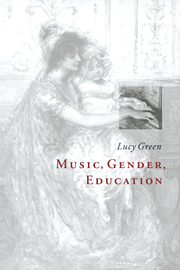Book contents
- Frontmatter
- Contents
- Acknowledgments
- 1 Introduction
- PART I MUSICAL MEANING AND WOMEN'S MUSICAL PRACTICE
- PART II GENDERED MUSICAL MEANING IN CONTEMPORARY EDUCATION
- 6 Affirming femininity in the music classroom
- 7 From affirmation to interruption of femininity in the music classroom
- 8 Threatening femininity in the music classroom
- 9 The music curriculum and the possibilities for intervention
- Bibliography
- Index
6 - Affirming femininity in the music classroom
Published online by Cambridge University Press: 20 November 2009
- Frontmatter
- Contents
- Acknowledgments
- 1 Introduction
- PART I MUSICAL MEANING AND WOMEN'S MUSICAL PRACTICE
- PART II GENDERED MUSICAL MEANING IN CONTEMPORARY EDUCATION
- 6 Affirming femininity in the music classroom
- 7 From affirmation to interruption of femininity in the music classroom
- 8 Threatening femininity in the music classroom
- 9 The music curriculum and the possibilities for intervention
- Bibliography
- Index
Summary
INTRODUCTION
In this second part of the book, I will enter the classroom, viewed as a microcosmic version of the wider society, to consider how gendered musical meanings, as discussed in Part I, can be seen to arise from and affect the practices and experiences of girls, boys and their teachers in the contemporary production and reproduction of gender through music education. First of all I will introduce the broad conception of schooling with which I am working, and then the general characteristics of music education within that conception. My focus will be on English secondary school music education, which I hope will provide an example from which implications for other countries, other systems of music education and other areas of musical life may emerge.
In Chapter I, I briefly introduced the concept of ‘historical grouping’, to imply both a verb and a noun: ‘grouping’ (or ‘to group’) is something that we do collectively; ‘a grouping’ (or ‘a group’) is something to which we belong (see Chapter I, n. I, p. 4 above). There is a circular relationship between the reproduction of historical groupings (including class, ethnicity or gender) at the societal level and the formation of identity at the individual level. The one feeds into, and helps to shape, the other. Historical groupings are reproduced partly through an ongoing, collective, discursive construction in which each individual takes part. Because of the interplay between the inertia of the social totality and the caprice of individual human agency, the reproduction of what exists goes hand in hand with the production of what is new – new structures, meanings, relationships, things.
- Type
- Chapter
- Information
- Music, Gender, Education , pp. 143 - 167Publisher: Cambridge University PressPrint publication year: 1997



